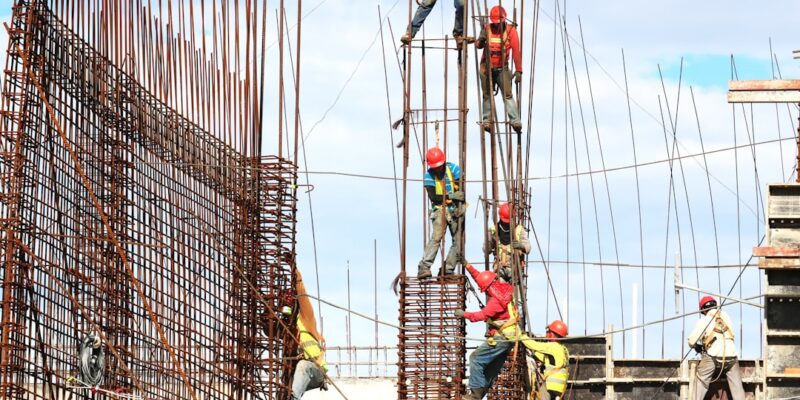
Building Your Dream Home: Understanding the Benefits of a Construction Line of Credit
In the construction industry, having access to financing is crucial for the success of any project. One of the most common forms of financing in the construction industry is a construction line of credit. A construction line of credit is a flexible and convenient financing option that allows contractors and builders to access funds as needed throughout the duration of a project. This article will explore what a construction line of credit is, its benefits, credit requirements, how to apply for one, and how to effectively manage it.
Key Takeaways
- A construction line of credit is a flexible financing option for construction projects.
- Benefits of a construction line of credit include access to funds as needed, lower interest rates, and improved cash flow management.
- Credit requirements for a construction line of credit may vary, but lenders typically look for a strong credit history and financial stability.
- Business credit is preferred over personal credit for a construction line of credit, as it separates personal and business finances.
- To apply for a construction line of credit, gather financial documents and prepare a business plan. Understand the terms and conditions before signing the agreement.
What is a Construction Line of Credit?
A construction line of credit is a type of financing that provides contractors and builders with access to funds on an as-needed basis during the construction process. Unlike a traditional loan, where the borrower receives a lump sum upfront, a construction line of credit allows the borrower to draw funds as necessary to cover expenses throughout the project.
The main difference between a construction line of credit and a traditional loan is the flexibility it offers. With a traditional loan, the borrower receives a fixed amount of money upfront and must make regular payments on the entire loan amount. In contrast, a construction line of credit allows the borrower to draw funds as needed and only pay interest on the amount borrowed.
Benefits of a Construction Line of Credit
One of the main advantages of having a construction line of credit is its flexibility. Construction projects often have unpredictable expenses and cash flow fluctuations. With a construction line of credit, contractors can access funds as needed to cover these expenses without having to go through the process of applying for additional loans or financing options.
Another benefit of a construction line of credit is its convenience. Contractors can easily access funds through their line of credit without having to go through lengthy approval processes or paperwork. This convenience allows for quick decision-making and ensures that projects can continue without delays.
A construction line of credit also helps with cash flow management. Contractors can use their line of credit to cover expenses such as materials, labor costs, and equipment rentals, allowing them to manage their cash flow more effectively. This is especially important in the construction industry, where payments are often delayed or staggered throughout the duration of a project.
Credit Requirements for a Construction Line of Credit
| Credit Requirement | Description |
|---|---|
| Credit Score | A numerical representation of a borrower’s creditworthiness based on their credit history and financial behavior. |
| Debt-to-Income Ratio | The percentage of a borrower’s monthly income that goes towards paying off debt. |
| Collateral | An asset that a borrower pledges as security for a loan. |
| Business Financials | Financial statements and tax returns that show the financial health of a borrower’s business. |
| Construction Experience | The amount of experience a borrower has in the construction industry. |
Obtaining a construction line of credit requires meeting certain credit requirements. Lenders will typically look at the borrower’s credit score, credit history, and financial statements to assess their creditworthiness.
Having a good credit score is crucial when applying for a construction line of credit. A higher credit score indicates a lower risk for lenders and increases the chances of approval. Lenders will also look at the borrower’s credit history to assess their ability to manage debt and make timely payments.
In addition to credit score and history, lenders will also review the borrower’s financial statements, such as income statements and balance sheets. These documents provide insight into the borrower’s financial stability and ability to repay the line of credit.
Business Credit vs Personal Credit for a Construction Line of Credit
When applying for a construction line of credit, both business credit and personal credit are taken into consideration. Business credit refers to the creditworthiness of the business itself, while personal credit refers to the creditworthiness of the individual or individuals behind the business.
While both types of credit are important, business credit is typically given more weight when applying for a construction line of credit. Lenders want to ensure that the business has a solid financial foundation and can generate enough revenue to repay the line of credit.
However, personal credit is still important, especially for small businesses or startups that may not have an established business credit history. Lenders will often look at the personal credit of the business owners or partners to assess their ability to manage debt and make timely payments.
How to Apply for a Construction Line of Credit
Applying for a construction line of credit involves several steps. Here is a step-by-step guide on how to apply for one:
1. Research and compare lenders: Start by researching different lenders that offer construction lines of credit. Compare their interest rates, terms, and requirements to find the best fit for your business.
2. Gather necessary documents: Before applying, gather all the necessary documents and information that lenders will require. This may include financial statements, tax returns, business licenses, and proof of insurance.
3. Prepare a business plan: A well-prepared business plan can help lenders understand your business and its potential for success. Include information about your experience in the construction industry, past projects, and future growth plans.
4. Complete the application: Fill out the lender’s application form with accurate and up-to-date information. Be prepared to provide details about your business, financials, and credit history.
5. Submit the application: Once you have completed the application, submit it to the lender along with any required documents. Some lenders may require additional documentation or may request an in-person meeting to discuss your application further.
6. Wait for approval: After submitting your application, you will need to wait for the lender to review and assess your application. This process can take anywhere from a few days to a few weeks, depending on the lender.
7. Review and accept the terms: If your application is approved, carefully review the terms and conditions of the construction line of credit before accepting it. Pay close attention to interest rates, repayment terms, and any fees associated with the line of credit.
Understanding the Terms and Conditions of a Construction Line of Credit
Before accepting a construction line of credit, it is important to fully understand the terms and conditions associated with it. This includes understanding the interest rates, repayment terms, fees, and any other conditions set by the lender.
Interest rates for a construction line of credit can vary depending on factors such as creditworthiness, market conditions, and the lender’s policies. It is important to understand whether the interest rate is fixed or variable and how it will impact your monthly payments.
Repayment terms for a construction line of credit can also vary. Some lenders may require interest-only payments during the construction phase, while others may require principal and interest payments. It is important to understand the repayment schedule and ensure that it aligns with your cash flow projections.
Fees associated with a construction line of credit can include origination fees, annual fees, and draw fees. These fees can vary depending on the lender and should be taken into consideration when evaluating the overall cost of the line of credit.
How to Manage Your Construction Line of Credit
Effectively managing a construction line of credit is crucial to ensure its benefits are maximized. Here are some tips on how to manage it effectively:
1. Monitor cash flow: Keep a close eye on your cash flow and ensure that you have enough funds available to cover expenses. Regularly review your line of credit balance and make strategic draws as needed.
2. Make timely payments: It is important to make timely payments on your construction line of credit to avoid any penalties or negative impacts on your credit score. Set up reminders or automatic payments to ensure that payments are made on time.
3. Communicate with your lender: If you anticipate any changes or challenges in your project that may impact your ability to repay the line of credit, communicate with your lender as soon as possible. They may be able to offer solutions or alternative arrangements.
4. Use funds wisely: Only draw funds from your line of credit when necessary and for project-related expenses. Avoid using the line of credit for personal expenses or non-essential items.
5. Regularly review terms and conditions: Periodically review the terms and conditions of your construction line of credit to ensure that you are still getting the best deal. If you find better terms or rates elsewhere, consider refinancing or renegotiating with your current lender.
Alternatives to a Construction Line of Credit
While a construction line of credit can be a valuable financing option, it may not be the best fit for every construction project. Here are some alternative financing options to consider:
1. Traditional loans: Traditional loans provide a lump sum upfront and typically have fixed repayment terms. This can be a good option for projects with predictable expenses and cash flow.
2. Equipment leasing: If you need specific equipment for your construction project, leasing can be a cost-effective option. Leasing allows you to use the equipment without the upfront cost of purchasing it.
3. Supplier credit: Some suppliers offer credit terms to contractors, allowing them to purchase materials and pay for them at a later date. This can help with cash flow management and reduce the need for additional financing.
4. Crowdfunding: Crowdfunding platforms allow individuals or businesses to raise funds for specific projects through online donations or investments. This can be a viable option for smaller construction projects or community-based initiatives.
Is a Construction Line of Credit Right for You?
In conclusion, a construction line of credit can be a valuable financing option for contractors and builders in the construction industry. Its flexibility, convenience, and ability to manage cash flow make it an attractive choice for many businesses.
However, it is important to carefully evaluate your financial situation and project needs before deciding if a construction line of credit is right for you. Consider factors such as creditworthiness, cash flow projections, and the specific requirements of your project.
By understanding the benefits, credit requirements, application process, terms and conditions, and effective management strategies of a construction line of credit, you can make an informed decision that best suits your business’s needs and goals.
If you’re interested in learning more about construction line of credit, you should definitely check out this informative article on Wave Magnets’ website. They provide valuable insights and guidance on how to effectively manage and utilize construction line of credit to support your construction projects. Whether you’re a contractor, builder, or developer, understanding the benefits and best practices of construction line of credit can greatly enhance your financial planning and project execution. Don’t miss out on this valuable resource, click here to read the article: https://wavemagnets.com/sample-page/.
FAQs
What is a construction line of credit?
A construction line of credit is a type of loan that provides funds to a borrower for the purpose of financing construction projects. It is a revolving credit line that allows the borrower to draw funds as needed and pay interest only on the amount borrowed.
How does a construction line of credit work?
A construction line of credit works like a credit card, where the borrower has a set credit limit and can draw funds as needed. The borrower only pays interest on the amount borrowed, and can repay the loan and draw funds again as needed. The loan is secured by the property being constructed, and the lender may require periodic inspections to ensure that the project is progressing as planned.
What are the benefits of a construction line of credit?
A construction line of credit provides flexibility and convenience to borrowers, as they can draw funds as needed and only pay interest on the amount borrowed. It also allows borrowers to manage their cash flow more effectively, as they can use the funds to pay for materials and labor as needed. Additionally, a construction line of credit can help borrowers build their credit history and improve their credit score.
Who can apply for a construction line of credit?
Anyone who is planning to build or renovate a property can apply for a construction line of credit. However, lenders may have specific eligibility requirements, such as a minimum credit score, income level, and debt-to-income ratio. Borrowers may also need to provide documentation such as construction plans, cost estimates, and proof of income.
What are the interest rates and fees for a construction line of credit?
Interest rates and fees for a construction line of credit vary depending on the lender and the borrower’s creditworthiness. Generally, interest rates are higher than traditional mortgage rates, and lenders may charge fees such as origination fees, appraisal fees, and inspection fees. Borrowers should carefully review the terms and conditions of the loan before applying.


















